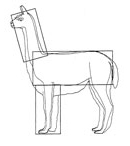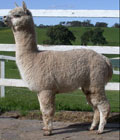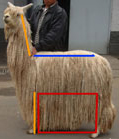Where you start your selecting depends upon what you want your alpacas for:
Health

The “box” shape of a
well conformed alpaca.
Health is important – your alpaca can live for over 15 years as long as s/he remains healthy. Feel along the backbone of the alpaca and ensure there is good muscle tone there. For a breeding alpaca, make your purchase conditional on a vet check or certificate of health. Also ask the owners vet to comment on the general herd health, herd disease (such as parasites) and to confirm the TB status of the herd.
Good reproductive health is essential in females. For young maiden alpacas, get a fertility guarantee. In a proven breeding female, ask to see her progeny on the farm. You can see her history of regular and successful births on the International Alpaca Registry (IAR) pedigree records. Ask about any gaps of over 18 months and about her ease of birthing. Check if there is a pregnancy and live birth guarantee.
Look and assess

A fleeced Huacaya alpaca
exhibiting good conformation.
Look at the structure or phenotype of the alpaca. The ideal alpaca has a “squared-off” appearance with a straight back and strong legs. The neck should be two thirds the length of the back, and the legs match the length of the neck. Teeth must meet the top jaw pad. Ears are straight and spear like. (Suri ears marginally longer) Suri’s differ from Huacaya in their fleece, their more rounded nose tip, and more toning on the backline.
Assess the temperament of the alpaca, and others in the herd, as this will tell you how sociable your new alpaca will be. Some alpacas come close when you call them, some can be over friendly and pushy, and some avoid human contact. Be comfortable with the nature of those you are buying.
Breeding Goals
Decide upon your alpaca farming goals if you are going to breed, as this will dictate what alpacas you buy, and what males you put your females to. Choose if Suri or Huacaya is your style. Think about colour preferences, and what you want to do with the fleece.
Ask for the statistics on how much the alpaca shears (shear weight) and the fineness. (A lower micron is finer) Consider lustre and the character of the fleece, whether it has a fine crimp (many crimps per length) or a broader crimp style.
Most breeders price finer micron alpacas and ones that are denser (have more shearweight) at a higher price than those that are not as fine or dense. Top genetics (especially from USA or Australia) can lift an alpaca’s price. Certainly a top pedigree as seen on the IAR records, can be an indication of a quality animal. If showing and ribbons is part of your breeding plan, then review show results for prominent sires.
Support

A fully fleeced Suri
showing good conformation.
Consider the support aspects offered with and after the sale. A farm visit to your place by the breeder to give tips on fencing, shelter and trees, and checking for poisonous plants would be nice. They may offer some assistance in the paperwork for joining the Alpaca Association and the Alpaca Registry, and contacting the nearest alpaca breeders cluster group. They can advise you of the local alpaca shearer, feed suppliers, and other breeders in the area.
Some breedersoffer education about fibre, nutrition, pregnancy and birthing. Larger breeders offer a re-mating service with a choice of stud males when your females have their cria (babies).
Visit alpaca breeders to see and ask questions first, then select where to buy. Make sure the breeder is someone you can call when you need to discuss anything, or have a concern. As in most things, do business with the breeders you get to know, like and trust.
So your new alpacas have been delivered, paid for, and are ensconced in your back paddock. Now you can start with the real business of getting to know them, spending lots of time leaning on the fences talking to them and spoiling them with treats!


